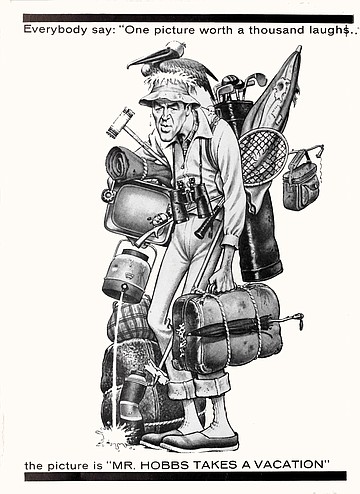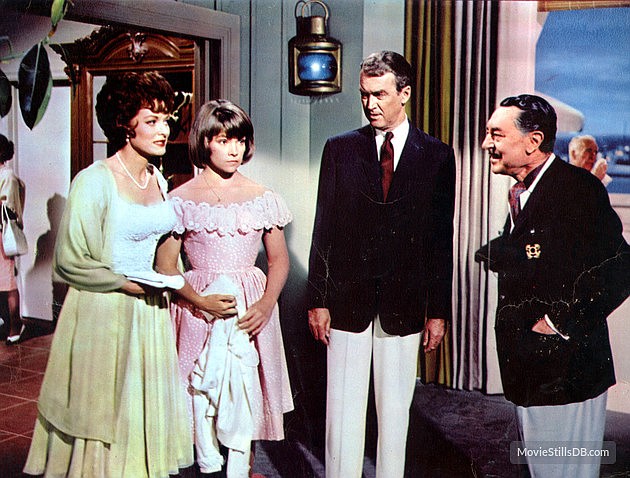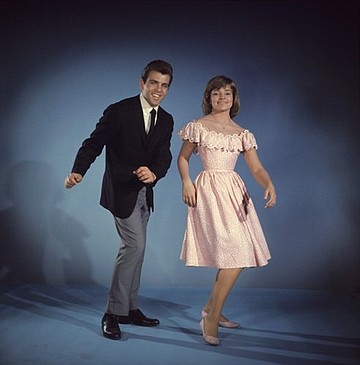 Facebook
Facebook
 X
X
 Instagram
Instagram
 TikTok
TikTok
 Youtube
Youtube

It’s a film once held in the highest esteem, one I proudly proclaimed the best picture of 1962! I was six at the time. Things might have been different had my parents dragged me to see Luis Buñuel’s The Exterminating Angel, adult Scotty’s top pick for ’62, but Babe and Larry never did cotton to films with the talking spelled out at the bottom.
With the summer vacation season rapidly dwindling to a close, let’s take a moment to revisit this fun-packed all-American family furlough. If perchance you identify with the conventionalism Hobbs and his gang go through, there’s a good chance you need to cut the white bread from your diet.

It was originally intended as a quiet summer by the shore for Roger Hobbs (Stewart), his wife Peggy (Maureen O’Hara), and their two youngest, Katey (Lauri Peters) and Danny (Michael Burns). After a brief introductory shot of Jimmy Stewart behind the wheel, all similarities between this and Vertigo cease to exist. Hobbs is a sullen, humorless, well-to-do Republican banker, contemptuous of almost every member of his family, who spends his days dictating long, vitriolic personal memos about them to his secretary on company time.
Why anyone would want to leave their peaceful suburban existence is uncertain. With a house as big as the one the Hobbs occupy, they could just as easily get lost for a couple of months in another wing. Wait until you see art director Jack Martin Smith’s hangar-sized bedroom sets (and hideous taste in wallpaper). All this space, yet Roger and Peggy still insist that Katey be shipped off to boarding school.
Their seaside escape is a ramshackle fixer-upper that houses a lot more character than the sterile colosseum they call home in St. Louis. The eyeless portrait of Rex Harrison hanging on the living room wall — left over from The Ghost and Mrs. Muir — alone makes the place a keeper. In order to ensure comic results, they are joined by more kids and grandkids, a dour-faced domestic, and son-in-laws — one with a prospective employer who, along with his carking spouse, materialize in the third act.

Of course everything that could possibly go wrong does. Studio hack Henry Koster tries to show his hand at comic invention by pitting Hobbs against a Rube Goldberg septic pump. It’s a running gag that barely limps.
Roger starts his own impromptu surfside book club with busty blonde neighbor Marika (Valerie Varda). While Hobbs attempts to fulfill his lifetime goal of making it all the way through War and Peace, it’s certain that he has Barry Goldwater’s The Conscience of a Conservative committed to memory. There’s even room for gamey double entendre. Marika, wanting to know the size of the bank Hobbs works for, asks “How big is it?,” causing Roger to blush and stammer. Stewart’s double-takes whenever Marika’s chest gets within range mark a career low point.
Continuing to smuggle in “adult” material, screenwriter Nunnally Johnson (The Grapes of Wrath, The Dirty Dozen), working from Edward Streeter’s novel, has Brenda (Minerva Urecal), the Hobbs’s Finnish cook, object to her employer’s filthy mouth after Hobbs mentions catching some “sun on the beach.” I could go on about Marie Wilson’s steamy “nude” scene, but Wilson held less “hubba hubba” than Julie Andrews and Doris Day combined.
The only thing Roger Hobbs has in common with It’s a Wonderful Life’s George Bailey is a loose-fitting newel post ornament at the foot of the staircase. Hobbs never pays attention to, gets involved with, or even communicates with his kids. He doesn’t notice Katey’s new braces. Danny is hooked on TV, so the instant antagonistic Roger returns home from work he purposely positions himself between son and set. Even third-generation Hobbs tremble in his quake. His bi-polar grandson, who takes great relish in calling Hobbs “Boom-pah,” repeatedly voices his hatred for the non-nurturing patriarch.
When I watched it as a child, Roger Hobbs appeared to be a great provider and ideal father figure. I understand his behavior more clearly now. He basically wants to get all of his kids out of the house, down pitchers of martinis with Peg, and screw. The film’s best scene, both then and now, takes place at a hip Yacht Club party hosted by a swingin’ Reginald Gardner (who appears to have grafted on Little Richard’s mustache). The distinguished St. Louis banker turns pimp when procuring Fabian’s services as an escort for his wallflower daughter. Fabian, in turn, prostitutes himself for a sawbuck and dances with Katey. He later palms a fiver on Roger, hoping for a possible musical interlude at Pizza Heaven and future bank job.

Henry Mancini’s score sounds like Frank De Vol when he wasn’t working for Robert Aldrich. During Fabian’s big number you’ll curl up, be my baby doll, and get enough “Cream Puff” on the brain to send one into diabetic seizure. In the opinion of this reporter, Fred Karger retooled Mr. Mancini’s theme for the equally troubled Phillips family in Hot Rods to Hell. Another Hell connection, “Boom-pah”-hater Peter Oliphant later played a patch of road kill opposite Dana Andrews.
Even with its rank use of widescreen and two pointless digressions (the “scatterbox” bonding scene and John McGiver’s interminable bird spotting), I can’t stop watching. Every summer since its letterboxed home video release in 2005, my DVD copy is freed from its clamshell housing and sent spinning.
There’s not much more to gripe about. Okay, the 4:30 am bird-watching jaunt appears to have been shot after lunch, but that’s okay. Hobbs has been inside my head so long that knocking it would be tantamount to maligning a favorite uncle, no matter how lame and unfunny he might have been.


It’s a film once held in the highest esteem, one I proudly proclaimed the best picture of 1962! I was six at the time. Things might have been different had my parents dragged me to see Luis Buñuel’s The Exterminating Angel, adult Scotty’s top pick for ’62, but Babe and Larry never did cotton to films with the talking spelled out at the bottom.
With the summer vacation season rapidly dwindling to a close, let’s take a moment to revisit this fun-packed all-American family furlough. If perchance you identify with the conventionalism Hobbs and his gang go through, there’s a good chance you need to cut the white bread from your diet.

It was originally intended as a quiet summer by the shore for Roger Hobbs (Stewart), his wife Peggy (Maureen O’Hara), and their two youngest, Katey (Lauri Peters) and Danny (Michael Burns). After a brief introductory shot of Jimmy Stewart behind the wheel, all similarities between this and Vertigo cease to exist. Hobbs is a sullen, humorless, well-to-do Republican banker, contemptuous of almost every member of his family, who spends his days dictating long, vitriolic personal memos about them to his secretary on company time.
Why anyone would want to leave their peaceful suburban existence is uncertain. With a house as big as the one the Hobbs occupy, they could just as easily get lost for a couple of months in another wing. Wait until you see art director Jack Martin Smith’s hangar-sized bedroom sets (and hideous taste in wallpaper). All this space, yet Roger and Peggy still insist that Katey be shipped off to boarding school.
Their seaside escape is a ramshackle fixer-upper that houses a lot more character than the sterile colosseum they call home in St. Louis. The eyeless portrait of Rex Harrison hanging on the living room wall — left over from The Ghost and Mrs. Muir — alone makes the place a keeper. In order to ensure comic results, they are joined by more kids and grandkids, a dour-faced domestic, and son-in-laws — one with a prospective employer who, along with his carking spouse, materialize in the third act.

Of course everything that could possibly go wrong does. Studio hack Henry Koster tries to show his hand at comic invention by pitting Hobbs against a Rube Goldberg septic pump. It’s a running gag that barely limps.
Roger starts his own impromptu surfside book club with busty blonde neighbor Marika (Valerie Varda). While Hobbs attempts to fulfill his lifetime goal of making it all the way through War and Peace, it’s certain that he has Barry Goldwater’s The Conscience of a Conservative committed to memory. There’s even room for gamey double entendre. Marika, wanting to know the size of the bank Hobbs works for, asks “How big is it?,” causing Roger to blush and stammer. Stewart’s double-takes whenever Marika’s chest gets within range mark a career low point.
Continuing to smuggle in “adult” material, screenwriter Nunnally Johnson (The Grapes of Wrath, The Dirty Dozen), working from Edward Streeter’s novel, has Brenda (Minerva Urecal), the Hobbs’s Finnish cook, object to her employer’s filthy mouth after Hobbs mentions catching some “sun on the beach.” I could go on about Marie Wilson’s steamy “nude” scene, but Wilson held less “hubba hubba” than Julie Andrews and Doris Day combined.
The only thing Roger Hobbs has in common with It’s a Wonderful Life’s George Bailey is a loose-fitting newel post ornament at the foot of the staircase. Hobbs never pays attention to, gets involved with, or even communicates with his kids. He doesn’t notice Katey’s new braces. Danny is hooked on TV, so the instant antagonistic Roger returns home from work he purposely positions himself between son and set. Even third-generation Hobbs tremble in his quake. His bi-polar grandson, who takes great relish in calling Hobbs “Boom-pah,” repeatedly voices his hatred for the non-nurturing patriarch.
When I watched it as a child, Roger Hobbs appeared to be a great provider and ideal father figure. I understand his behavior more clearly now. He basically wants to get all of his kids out of the house, down pitchers of martinis with Peg, and screw. The film’s best scene, both then and now, takes place at a hip Yacht Club party hosted by a swingin’ Reginald Gardner (who appears to have grafted on Little Richard’s mustache). The distinguished St. Louis banker turns pimp when procuring Fabian’s services as an escort for his wallflower daughter. Fabian, in turn, prostitutes himself for a sawbuck and dances with Katey. He later palms a fiver on Roger, hoping for a possible musical interlude at Pizza Heaven and future bank job.

Henry Mancini’s score sounds like Frank De Vol when he wasn’t working for Robert Aldrich. During Fabian’s big number you’ll curl up, be my baby doll, and get enough “Cream Puff” on the brain to send one into diabetic seizure. In the opinion of this reporter, Fred Karger retooled Mr. Mancini’s theme for the equally troubled Phillips family in Hot Rods to Hell. Another Hell connection, “Boom-pah”-hater Peter Oliphant later played a patch of road kill opposite Dana Andrews.
Even with its rank use of widescreen and two pointless digressions (the “scatterbox” bonding scene and John McGiver’s interminable bird spotting), I can’t stop watching. Every summer since its letterboxed home video release in 2005, my DVD copy is freed from its clamshell housing and sent spinning.
There’s not much more to gripe about. Okay, the 4:30 am bird-watching jaunt appears to have been shot after lunch, but that’s okay. Hobbs has been inside my head so long that knocking it would be tantamount to maligning a favorite uncle, no matter how lame and unfunny he might have been.
Comments